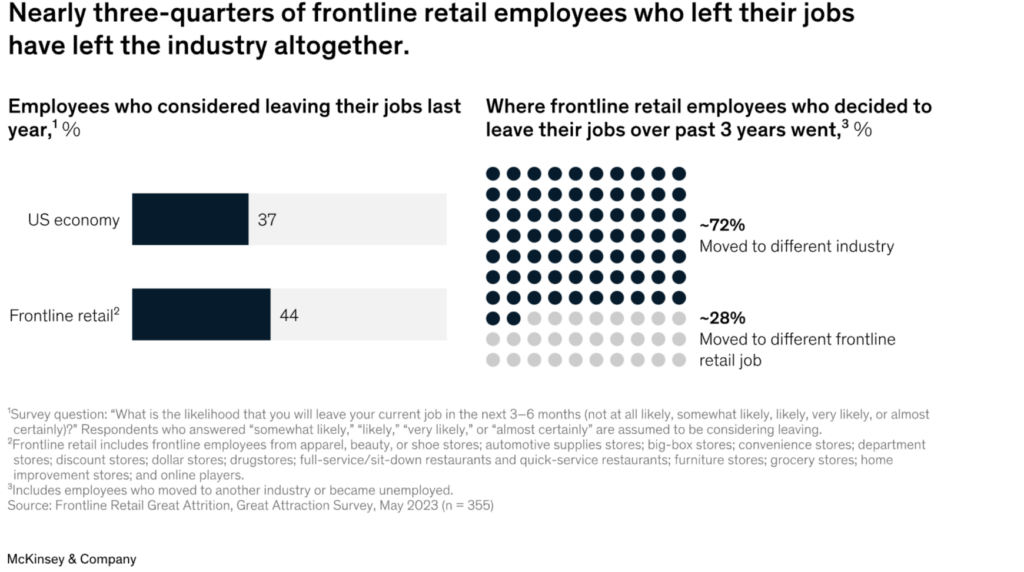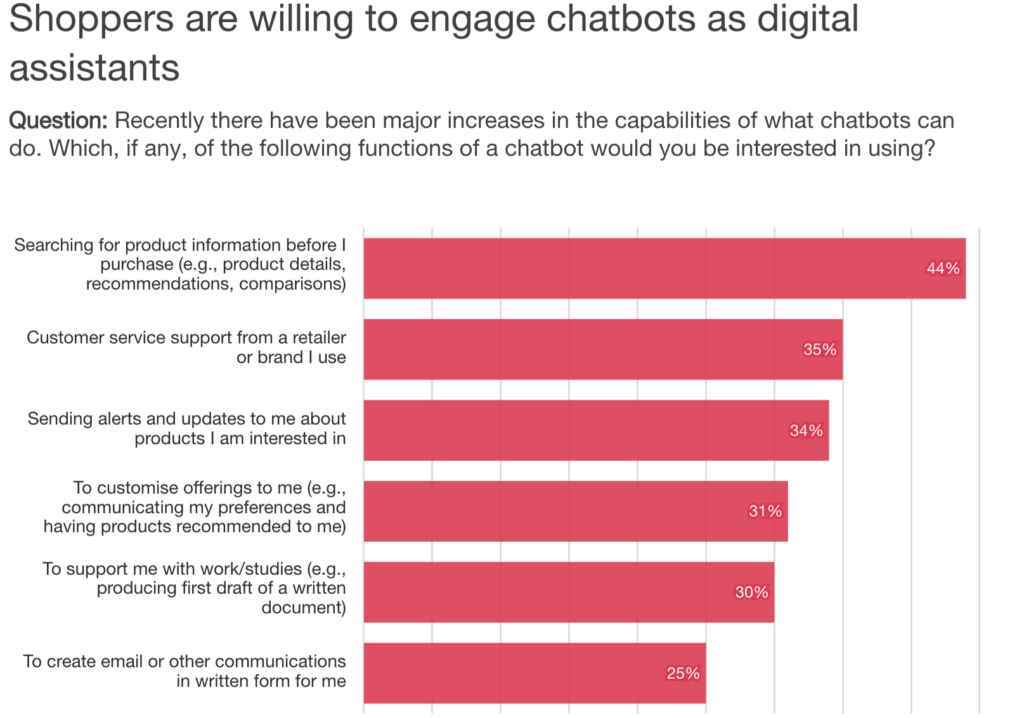The retail sector had a few rocky years. First, the global pandemic rewired shopping behaviors and global supply chains. Then, rising inflation and the cost of living reduced discretionary spending. The sector struggles with a more systemic issue: high frontline employee turnover and subsequent labor shortages.
What’s Driving Frontline Retail Workers Shortages?
The Great Resignation that began early in 2021 left retailers with smaller labor forces. In 2022, Amazon executives were worried that they may run out of people to hire for their warehouses by 2024. Though that didn’t happen.
Amends were soon to follow: Higher pay, more flexible hours, better benefits, and higher performance-based bonuses. Still, despite a greater focus on employee retention retailers continue to face acute frontline labor shortages in 2024.
A survey by Quinyx found that 85% of frontline US workers report high levels of stress, mostly driven by low pay and long working hours. Subsequently, almost 60% are considering quitting their jobs in 2024. What’s even more worrisome, is that three-quarters of frontline employees who left the job never return to the retail industry.

European retailers face similar issues. Economic, policymaking, and power shifts in the labor market have left companies with a smaller talent pool. According to Deloitte, 62% of European retail leaders expect competition for qualified and skilled talent to intensify this year.
With an exodus of frontline employees and high discontent rates among those that remain, retailers risk losing in their biggest battle — differentiation from customer experience (CX).
Customer experience is already a bigger influence on shopping decisions. For 88% of buyers, the experience a company provides matters as much as its products or services.
The proof is in the pudding: Companies that excel in CX increase sales revenues by 2% to 7% annually and profitability by 1% to 2%.
For retailers, the frontline workforce is the driving force behind CX — and by investing more in your employee’s experience, you can drive improvements in other operational areas: increase operational efficiencies, optimize costs, and unlock new revenue streams.
Why Invest in Retail Employee Experience
Fact: Happy workers are 13% more productive. Big Tech companies already recognize this axiom. At Google, workforce productivity increased by 37% after investing more in employee support and employee satisfaction initiatives.
Retailers, however, are only realizing the value of providing great employee experience (EX).
But those who do, already see substantial returns. Wegmans Food Markets, Inc., the only retail company in the top 10 on the “Fortune 100 Best Companies to Work For in 2024” list (and present on the list for 25 consecutive years) was one of the first retailers to double down on EX.
Their base pay is hardly more competitive than that of Walmart or Costco, for instance. But they've cultivated greater employee satisfaction and retention by investing in other areas:
- Flexible schedules. 94% of employees say that they can take time off from work when it's necessary. The company accommodates flexible scheduling and allows remote work for certain positions.
- Employee appreciation. 96% say that they’re made to feel welcome when joining the company through effective onboarding and training. The company also has multiple listening channels to collect feedback and act upon employees’ ideas. Dedicated Employee Advocates also serve as objective advisors, facilitators, and coaches for staff and help shape the leadership agenda.
- Necessary tools and resources. 93% agree that the facilities contribute to a good working environment. The retailer also continuously invests in new technologies for its employees like AI-powered digital assistants and invests heavily in employee upskilling to help them master new technical skills. Every year 25% of all Wegmans employees receive a new career development opportunity.
By investing more in employee experiences Wegmans reduces talent attrition and maintains high customer satisfaction scores. Both drive faster revenue growth.
Wegmans is hardly an outlier. Almost 75% of retailers with mature EX strategies achieve double-digit revenue growth year over year, compared to only 49% of retailers with low-maturity EX strategies.
6 Technologies That Improve Frontline Employee Experiences and Drive Growth For Retailers
Until recently, the majority of tech budgets in retail went towards customer-facing solutions: better e-commerce platforms, more resilient cloud architecture, or omnichannel payment services.
Subsequently, only 23% of frontline workers say they have access to the technology they need to be productive and do their jobs well. Yet, investments in frontline retail technologies can drive as high (if not better) impacts for businesses.
A happier, more productive frontline workforce can help you drive superior business results through the six technologies listed below.
Digital Workplace Assistants
Omnichannel has become the dominant operating model for retailers. But frontline employees often remain ‘disconnected’ from the large fraction of operating systems when they roam the floors.
Only 13% of the retail employees surveyed by Accenture feel that they are omni-connected at work — that is, have access to all the tools, information, and communication channels they need to do their best work. However, of employees that have the omni-connected experience 94% say they can be productive anywhere. Access to convenient workplace tools also accounts for 59% of a retail employee’s intention to stay with the company.
That’s why leading retailers are investing in better digital workplace solutions.
For instance, Home Depot launched a mobile workforce app in 2023. Powered by machine learning, the tool creates a prioritized task list for each sales associate to maximize their productivity. For example, it can direct them to restock the shelf with the highest-demand products first or provide navigation around the warehouse to retrieve the missing product quickly.
Target, in turn, plans to roll out a generative AI assistant later in the year to provide hot-key help to new and seasoned associates. The mobile assistant can provide quick answers to common questions like “How to restart a cash register?”, plus provides access to personalized corporate training resources.
With digital assistants, sales associates can solve trivial problems faster and focus on tasks that matter more, saving time and improving their performance.
Robotic Process Automation (RPA)
Robotic process automation (RPA) tools help automate a lot of menial, repetitive tasks, related to data entry, validation, and exchanges. Effectively, what RPA does is automate the manual steps in sequential business processes like invoice processing or order management that currently require manual data entry and switching between different apps.
Adoption of RPA can reduce the time frontline employees spend on manual:
- Daily cashier reporting
- Invoice processing for online orders
- Return processing
- Stock management in-store
- Price and promotion updates
- Refund authorization
- Shift scheduling
The great advantage of RPA solutions is that the technology is relatively easy to implement, thanks to low-code platforms. It also costs a fraction of custom integration development between applications. Combined with great flexibility in use cases and deployment scenarios, an RPA can be easily scaled to cover a wide range of retail processes within a relatively short period.
Leroy Merlin, for example, used Apian platform to digitize and streamline its returns and refunds process. Previously, the teams had to manually complete a lot of paperwork and send different requests to multiple apartments. Data entry errors led to occasional financial losses while overlapping tasks and lack of oversight during order fulfillment added to delays and delivery cancellations.
With Apian, Leroy Merlin removed 90% of the manual steps. An intelligent document processing now automatically collects all the necessary information and routes it to respective divisions. The entire process from return processing to refund issue now takes 1.5-2 days on average over two weeks before RPA adoption, increasing both EX and CX.
Digital Inventory Management Systems
Fractured supply chains have left retailers with frequent stock-outs — a factor consumers can’t fail to notice. For 43% of consumers, ‘competitive pricing’ and ‘better availability of stock’ are key reasons for shopping with the retailer.
Yet, retailers and in-store associates are ‘blind’ to accurate inventory data 30% of the time due to information silos, lack of effective stock tracking methods, and errors in inventory counts. This, in turn, hampers customer experience.
Fluent found that 38.6% of retailers cancel at least 1 of 10 orders due to stock visibility issues, regularly disappointing 10% of their customer base. Only 6% of retailers cancel less than 1% of orders.
If that sounds like your case, you may want to upgrade your order management system (OMS). Modern, integrated solutions can help with order orchestration across channels while also ensuring end-to-end inventory visibility.
An integrated OMS centralizes inventory data from all sources — stores, warehouses, fulfillment centers, and online channels — to give you a 360-degree view of your inventory levels across locations. Inventory data can be automatically aggregated using barcodes, RFID tags, or computer vision systems.
Popular athleisure retailer Lululemon uses RFID tags throughout its store network since 2021, which allows it to maintain a 98% inventory accuracy rate. High visibility levels allow the company to delight consumers with real-time in-store availability information and ensure more effective stock level management at the back. The team can manage inventory levels across its stores and fulfillment centers to ensure better assortment selection and faster shipping of online orders.
In-Store Fulfillment Centers
High inventory visibility is critical to accommodate fast and reliable omnichannel order fulfillment. Consumers have come to expect various order pick-up options: ship-to-store, BOPIS, curbside pickup, and express at-home delivery.
Respondents in the Digital Commerce 360’s study indicate their expectations for shipping experiences are rather high: it has to be free (82%), fast (68%), and quickly fulfilled (59%)
To meet these expectations retailers are increasingly investing in in-store fulfillment centers.
An in-store fulfillment model involves using select retail locations as fulfillment centers for online orders. By building a network of in-store fulfillment centers, retailers can reduce shipping delays and delight customers with more options for returns and exchanges.
However, this order fulfillment model also requires investments in extra technologies, namely an integrated order management system and an inventory management system that provides real-time visibility into stock levels across all stores and warehouses, as well as tools for associates to receive, process, and pick orders.
Australian fashion retailer Forever New, for example, adopted OneView unified commerce platform to power up its in-store fulfillment model. The platform provides retail associates with real-time inventory visibility and a single view of customer transactions to handle incoming orders.
Larger retailers like Walmart are taking this step further with a robotics system for in-store order processing. In 2023, the company opened a high-tech fulfillment center at one of its stores, equipped with a proprietary robotics storage and retrieval system. As Walmart digitizes fulfillment, it aims to increase customer satisfaction and improve associate opportunities by shifting its focus from labor-intensive work to more strategic initiatives.
Endless Aisle Solutions
Ecommerce volumes are on the rise, but brick-and-mortar locations still account for 80% of retail transactions. Yet, in-store consumer behaviors are largely influenced by digital touchpoints.
Almost half of in-store shoppers used a smartphone to enhance their most recent in-store shopping journey. Most of the time, they go online to verify stock availability and compare prices. When items are out-of-stock (OOS), retailers lose more than a sale.
To avoid carrying excessive inventory and losing profits to OOS, retailers are experimenting with endless aisle solutions.
Endless aisles are a collection of technologies retailers use to allow customers to order products they can't normally find in-store or that are currently out of stock. Typically, it’s a self-service kiosk, connected to the company’s inventory and fulfillment systems, which allows customers to place an in-store order and select the optimal pickup mode. Some solutions also include an option to customize product configurations, personalize design, or get an extended warranty.
Retailers can offer a wide range of merchandise without expanding their physical premises or putting more pressure on their employees. A self-service kiosk serves as an extra touchpoint with consumers, allowing you to collect more data on their preferences and shopping behaviors. By combining in-store and online trends, you can gain a 360-view of consumer behaviors to inform your merchandising, inventory management, and promotion strategies.
Apparel retailer Bon-Ton recently introduced self-service kiosks across its store network. Apart from offering a sleek payment experience, the system also promotes easy product discovery. All the shoes are outfitted with an NFC tag, which allows shoppers to tap the shoe sole with their phone to check if their size is in-store or order the same model via their phone.
By seamlessly blending digital and physical experiences, retailers can minimize revenue loss to OOS while also improving conversions and in-store experiences—all without putting extra strain on the in-store workforce.
Self-Service Customer Portals
The customer service function is often seen by retailers as a major cost center. Yet, its strong performance has a direct impact on revenue. Forrester research suggests that customer-obsessed brands see an ROI of at least 700% over 12 years, depending on company size and customer type.
Even better news is that customers have become more lenient towards automated and self-service channels. According to a PwC survey, shoppers are interested in using chatbots to get more product information, get their issues resolved, and receive product alerts.
A.T. Kearney estimated that out-of-stock also hinders customer loyalty, order fulfillment, and shipping costs.
Retailers are experimenting with endless aisle solutions to avoid carrying excessive inventory and losing profits to OOS.
Endless aisles are a collection of technologies retailers use to allow customers to order products they can't normally find in-store or that are currently out of stock. Typically, it’s a self-service kiosk, connected to the company’s inventory and fulfillment systems, which allows customers to place an in-store order and select the optimal pickup mode. Some solutions also include an option to customize product configurations, personalize design, or get an extended warranty.
Retailers can offer a wide range of merchandise without expanding their physical premises or putting more pressure on their employees. A self-service kiosk serves as an extra touchpoint with consumers, allowing you to collect more data on their preferences and shopping behaviors. By combining in-store and online trends, you can gain a 360-view of consumer behaviors to better inform your merchandising, inventory management, and promotion strategies.
Apparel retailer Bon-Ton recently introduced self-service kiosks across its store network. Apart from offering a sleek payment experience, the system also promotes easy product discovery. All the shoes are outfitted with an NFC tag, which allows shoppers to tap the shoe sole with their phone to check if their size is in-store or order the same model via their phone.
By seamlessly blending digital and physical experiences, retailers can minimize revenue loss to OOS, while also improving conversions and in-store experiences — all without placing extra toll on the in-store workforce.
Self-Service Customer Portals
The customer service function is often seen by retailers as a major cost center. Yet, its strong performance has a direct impact on revenue. Forrester research suggests that customer-obsessed brands see an ROI of at least 700% over 12 years, depending on company size and customer type.
Even better news is that customers have become more lenient towards automated and self-service channels. According to a PwC survey, shoppers are interested in using chatbots to get more product information, get their issues resolved, and receive product alerts.

Recent advancements in generative AI have also made chatbot conversations more helpful and effective. By combining gen AI assistants with digital self-service support channels, organizations can now effectively handle 70%-80% of customer interactions without human involvement.
At the same time, gen AI assistants can also co-pilot human agents in issue resolution, providing contextual tips in real time. Best Buy, for example, recently launched an AI assistant for its customer support workforce. The tool provides phone agents with real-time conversation summaries, response prompts, and customer sentiment analysis, which allows the agent to tailor their responses more effectively.
What’s more, AI assistants can be a new customer engagement tool, offering helpful product recommendations and buying tips. Ikea recently launched a ChatGPT-based assistant, which allows shoppers to explore the company’s product catalog, model different room designs, verify product availability across stores, and discover new design ideas.
Conclusion
As sand can fill the open space in a jar of stones, digital technologies are helping retailers compensate for talent shortages. Better analytics systems, workforce assistants, and automation technology empower frontline teams to work smarter, not harder. By curbing manual work and inefficiencies, your workforce can focus more on delivering superior in-store and offline customer experiences.
As the above cases prove, retailers that invest in digital technologies improve their profit margins, reduce operating costs, and increase customer satisfaction faster than those that don’t. Get in touch with Svitla Systems to learn more about how to put technology at the best service of your customers and your business.




![[Blog cover] SEO optimization best practices](https://svitla.com/wp-content/uploads/2025/05/Blog-cover-SEO-optimization-best-practices-560x310.jpg)